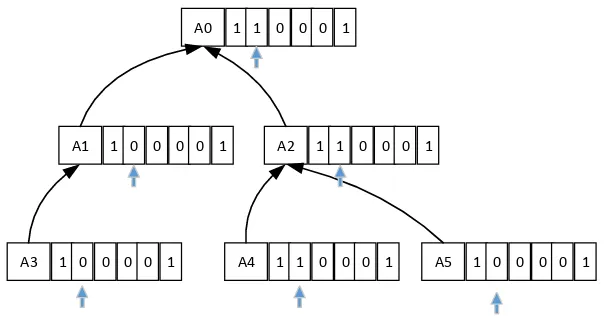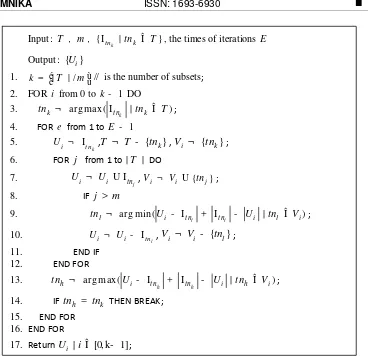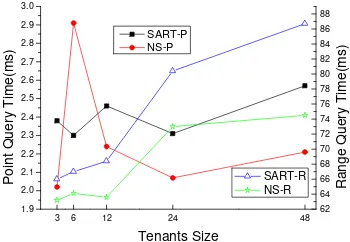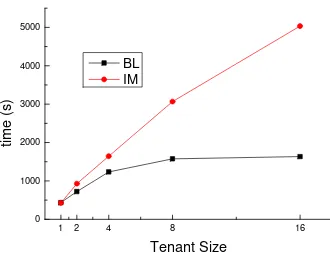DOI: 10.12928/TELKOMNIKA.v14i2A.4361 77
Multi-tenant Main Memory Index Tree with Shared
Structure
Lida Zou1, Qingzhong Li*2, Lanju Kong3
1,3
School of Computer Science and Technology, Shandong University, Jinan, Shandong 250101, China
2Electronic Commerce Research Center of Shandong University, Jinan, Shandong 250101, China
*Corresponding author, e-mail: [email protected], [email protected]
Abstract
Multi-tenant main memory index is an important tool to accelerate data access to software as a service. Establishing main memory indexes for each tenant occupies lots of memory space and results in performance bottleneck. The data schemas and access patterns of different tenants are similar, which provides the conditions for tenants storing their index entries with shared structure in main memory. In the paper, the designed structure of main memory index puts the indexes of different tenants on one tree to achieve the effects of saving memory space. Meanwhile, tenant placement algorithm in the cloud is proposed. Its places the tenants with similar indexes on the same node to further optimize the main memory space.
Keywords: Multi-tenant database; Main memory index; Tenants placement; SaaS
Copyright © 2016 Universitas Ahmad Dahlan. All rights reserved.
1. Introduction
With the fast development of cloud computing, many Software as a Service (SaaS) [1, 2] providers deploy tenant applications in the cloud. The excellent multi-tenant database is the basis for multiple tenants to quickly access the data. With the falling cost of main memory, tenant data and indexes are gradually placed into main memory, which reduces the times of disk I/O and speeds up data processing.
The indexes in main memory are critical for quick and correct access to multi-tenant data. In multi-tenant database, many tenants share the processing resources. If indexes are separately built for each tenant in the scarce memory, access performance isolation is achieved but lots of memory space is occupied. It further leads to memory resource starvations. Ablut et al. [3] experimentally validate that the multi-tenant database with share schema has a high performance. The schema is also widely used in industry field [4]. Due to the similarity of tenant business, multi-tenant database with share schema usually build indexes for tenants on the same attributes of a data schema. This provides the conditions for the sharing of multi-tenant indexes in main memory.
multi-the same node. Experiments demonstrate that it saves space 20% than multi-the benchmark solution. The rest of the paper is organized as follows. Section 2 introduces the related work. In Section 3 we give the structure of multi-tenant shared memory index and its related operations. Section 4 discusses a multi-tenant placement algorithm based on central tenants in the cloud. Experimental results are presented in Sections 5 and 6 concludes the paper.
2. Related Work
For the shared schema of multi-tenant data, index management is an important part of efficient querying. Weissman et al. use a series of Pivot Tables to store tenants’ indexes in the Force.com cloud [1], which achieves the quick access to tenant data. Aulbach et al. [6, 7] propose multiple shared schemas of multi-tenant data and design the methods of building indexes on Chunk Table. It divides tenant data into two kinds and respectively stores them in two tables depending on whether tenants have the demands of building indexes. The indexes are built on one table and the other table is not indexed, which guarantees isolation for tenant indexes in lower resource cost. The above studies give the solution to index isolation problem, and ignore the performance bottleneck caused by too many indexes stored in the main memory. In the aspect of main memory index, many algorithms such as ART [5], Red-black trees [6, 7] and T-trees [7] are proposed and widely used, where ART performs better in both performance and space efficiency. ART is an adaptive radix tree for efficient indexing in main memory and each node in the tree dynamically adjusts its space size according to the number of keys. ART saves the space, but does not discuss the main memory index structure of multi-tenant data. In the paper we propose a main memory index tree shared by multiple multi-tenants. The tree is based on ART, and saves the space through sharing an ART by tenants.
3. Multi-Tenant Shared Main Memory Index
For the shared schema of multi-tenant data, index management is an important part of efficient querying. Weissman et al. use a series of Pivot Tables to store tenants’ indexes in the Force.com cloud [1], which achieves the quick access to tenant data. Aulbach et al. [6, 7] propose multiple shared schemas of multi-tenant data and design the methods of building indexes on Chunk Table. It divides tenant data into two kinds and respectively stores them in two tables depending on whether tenants have the demands of building indexes. The indexes are built on one table and the other table is not indexed, which guarantees isolation for tenant indexes in lower resource cost. The above studies give the solution to index isolation problem, and ignore the performance bottleneck caused by too many indexes stored in the main memory. In the section we first give the related definitions of multi-tenant main memory index and then show the structure and operations of the index tree.
Let tn ,k k = 0,1, 2,... denote a tenant and I ii, = 0,1, 2,.... denote an index. Multi-tenant database builds several indexes for a tenant and the index set of a tenant is denoted as
I { | ” }
k
tn = Ii Ii tnk . If different tenants build the index on the same attribute of a schema, we
call it index overlap. If I , I
k l
i tn j tn
I Î I Î stands and there exists an overlap between index Ii
A0 1 1 0 0 0 1
A1 1 0 0 0 0 1 A2 1 1 0 0 0 1
A5 1 0 0 0 0 1
A4 1 1 0 0 0 1
A3 1 0 0 0 0 1
Figure 1. The structure of main memory index tree shared by multiple tenants
When several indexes overlap, they are put into a MSM. The structure of MSM is shown in Figure 1. Each node in the tree includes ART data and tenant privilege information. Assuming that is a tree node in MSM, the ART data of is generated referring to literature [5]. The privilege information of is used to describe which tenants the subtree rooted by the tree node belongs to. The privilege information of has bits, where is the number of tenants using the
index. We use bi Î {0,1},i = [0,n- 1] to denote a bit of tenant privilege information. Mapping
function F tn( k) is created to get the location of privilege information for the tenant according to tenant ID. If holds, represents that there are index entries belonging to tenant
k
tn on the subtree rooted by , while represents that the index entries with oj as an ancestor do not belong to tenant . The correspondence between tenants of mapping function
and the expressed locations is stored in the main memory. Next we give the operations of tenant on MSM and assume
Point query. The goal node is searched from root node in MSM according to ART querying algorithm. If leaf node is reached and its value is 1, the data storage address is returned. If the values of the nodes on the search path are 0, the failure information of querying is returned. Point queries just need to determine the value of when searching each node. Thus its efficiency is the same with ART.
Range query. Assume the query range is , . The main steps are as follows.
(1) Point query is used to search the value . We set as the leaf node when searching the value a or the tree node whose is 0 when the search stops.
(2) Find the parent node of . If the value of is 0, go to step (8). (3) Put all the child nodes of in reverse order into a stack.
reaches , .
Insertion and Deletion. When a tenant inserts or deletes a key, it refers to the operations of ART algorithm and updates the corresponding bits of tenant privilege information. If the splitting and merging of tree nodes are involved, the bits of tenant privilege information for the new node are the join operation on the bits of the child nodes.
Bulk Load. In the cloud, data engine usually migrates tenant data from one node to another node in consideration of loads and security. When tenant data are migrated, their main memory indexes are migrated as well. Assume that the goal computing node has an index , and the data of the migrated tenants has an index . If holds, all the index entries belonging to the migrated tenants in needs to be bulk loaded into , which realizes the sharing of index tree for the goal computing node. The intuitive bulk-loading method is to first export all the index entries belonging to the migrated tenants in , then transfer them to the goal computing node and last insert them into . The method needs to first export and then import, whose time efficiency is low. In the paper we give a bulk load scheme based on privilege information to improve its loading efficiency. Let M denote the set of the migrated tenants, i.e., the data and indexes of the tenants in need migrating. The steps of index bulk loaded into are as follows: (1) Transfer to the goal computing node. (2) Choose each leaf node in . (3) Let denote one leaf node. Examine the privilege information in , and determine whether the index entry in belong to a tenant in . (4) If the index entry belongs to the tenant in , insert the index entry in into and change the privilege information of . In Section 5, experiments will validate its efficiency.
Multiple tenants share the main memory based on MSM, and operate the index entries separately without influencing the other tenants. Next section we extend MSM in the cloud according to the characteristics of tenant indexes.
4. Multi-Tenant Placement Algorithm Based on Central Tenants in the Cloud
Figure 1. Central tenants grouping algorithm
The index set of tenant tnk is denoted as Itnk = {Ii |Ii ” tnk} and the tenant set is denoted as . If the number of tenants served by each computing node is , the problem is to solve the subsets Vi |i Î [0, |êéT | /múù- 1] of éê|T | /mùú tenants when the number of tenants in
each subset is no greater than m . These subsets make
[0, |T|/ m 1] i
The intuitive way of getting the optimal solution is enumerating, but its time complexity is O T(| | !). In the paper we propose a heuristic algorithm called central tenants grouping algorithm. Its main steps are as follows.
Algorithm 1 gives the concrete steps. Its time complexity is O T(| |2 E) and has a higher execution efficiency. In section 5.2 Algorithm 1 will be experimentally proven to better save main memory space.
5. Results and Discussion
In the section we first test the space occupation and access performance of MSM, and then validate the influence of central tenants grouping algorithm on main memory space in the cloud.
We use OpenStack to build our experimental environment. Each computing node has a 64-bit Ubuntu system, 4 CPUs, 8G memory, 200GB of storage space. The networks of the computer nodes are built by high-speed switches with a speed of 9120Mpps. The number of virtual nodes is from 2 to 16. The cache capacity of each node is set to 8G. We choose the mode structure of TPC-C [8] to generate tenant data. Multi-tenant data processing is online and transactional, such as the customer relation management product in Salesforce. TPC-C is an OLTP base a project simulating goods management environment of a wholesaler and can be deployed on a multi-tenant data platform. Each tenant has 8 indexes and 106 tuples, and index entries are randomly generated for each index [9-15].
5.1. Space Occupation and Access Performance of MSM
Figure 2 gives the comparison on space occupation of MSM and NS. NS is the method of creating independent indexes for each tenant using ART. As seen in Figure 2, for 3 tenants MSM occupies 30% less space than NS. It is also observed that the occupied space of NS grows quickly with the increasing tenants. However, the occupied space of MSM ascends slowly, because the more the tenants are, the more the overlapped index entries are [16].
3 6 12 24 48
Figure 2. The space occupation with the number of tenants
3 6 12 24 48
Figure 3 shows the comparison on data access performance of MSM and NS. MSM-P and NS-P denote their point queries, respectively. The data reveal that the data access times of the two index structures are 2ms or so. MSM-P and NS-P have the similar access efficiency. MSM-R and NS-R represent the range queries of the two index structures. The figure shows that MSM-R has longer query time but not exceeding 15% of that of NS-R. When the number of tenants is small, the time of range query in MSM is similar to that in NS. When the number of tenants is large, the query time of MSM ascends, since MSM needs to check the privilege information of each node. Because the range query method of MSM could avoid traversing the leaf nodes not belonging to the tenant, its query time does not increase significantly with the expanding number of tenants.
1 2 4 8 16
0 1000 2000 3000 4000 5000
ti
me (s
)
Tenant Size BL
IM
Figure 4. The bulk loading performance with the number of tenants
Figure 4 gives the performance of bulk loading scheme based on privilege information. We compare the proposed bulk loading scheme based on privilege information (BLPI) with the intuitive loading method (ILM). ILM first exports the index entries belonging to the migrated tenants on the original node, then transfer them to the goal computing node and last insert them into the shared index tree in turn. The experiments demonstrate that BLPI has more advantages on the bulk loading time, especially when the number of tenants is large. This is because BLPI avoids inserting the index entries of all the tenants on the index tree, but does the insertion in the granularity of leaf node.
5.2. Space Occupation of Central Tenants Placement Algorithm
Figure 5 demonstrates the influence of Central Tenants Placement algorithm (CTP) on the occupied space. We compare CTP with Random Placement Algorithm (RDP). In cloud computing environment, the number of tenants each computing node holds is 8, and the number of computing nodes ranges from 2 to 16. It is seen that CTP performs well on the occupied space when the number of nodes is large.
7 8
In the paper we propose a multi-tenant main memory index tree with shared structure to address the issue of multi-tenant indexes occupying too much memory space. The tree stores the multiple indexes built on the same attribute on one index tree, which achieves the effect of space savings. The operations of the proposed tree are given, whose performance reduces no more than 15% than that of the isolated indexes. A multi-tenant placement algorithm in the cloud is presented as well. It puts the tenants with high index overlap ratios on a computing node to further reduce the occupation of main memory space.
Acknowledgements
This work is supported by National Natural Science Foundation of China under Grant No. 61572295, No. 61303085; Natural Science Foundation of Shandong Province under Grant No. ZR2013FQ014, No. ZR2014FM031; Science and Technology Development Plan Project of Shandong Province No. 2014GGX101047; Shandong Province Independent Innovation Major Special Project No. 2015ZDJQ01002, NO. 2015ZDXX0201B03.
References
[1] Gang Li, Xiaofeng Zhao, Dianzhong Wen, Yang Yu. Research on Silicon-based Planar Spiral Inductance Coil Based on Microelectromechanical System. TELKOMNIKA (Telecommunication Computing Electronics and Control). 2015; 13(4): 1127-1132.
[2] M Malawski, M Kuzniar, P Wojcik, M Bubak. How to use Google App engine for free computing. Journal of Internet Computing. 2003; 17(3): 50-59.
[3] Aluvalu RK, Kamliya V, Muddana L. HASBE access control model with Secure Key Distribution and Efficient Domain Hierarchy for cloud computing. International Journal of Electrical and Computer Engineering (IJECE). 2016; 6(2): 770-777.
[4] Das S, Narasayya VR, Li F, et al. CPU sharing techniques for performance isolation in multi-tenant relational database-as-a-service. Proceedings of the Vldb Endowment. 2013; 7(1): 37-48.
[5] BOH Akinwole, Biebuma JJ. Comparative Analysis of Empirical Path Loss Model for Cellular, Transmission in Rivers State. American Journal of Engineering Research. 2013; 2(8): 28-34.
[6] R Binna, D Pacher, T Meindl, G Specht. The DCB-Tree: A Space-Efficient Delta Coded Cache Conscious B-Tree. Proceedings of the 2015 Lecture Notes in Computer Science, Hongzhou, China. 2015; 1-2.
[7] S Chen, Q Jin. Persistent b+-trees in non-volatile main memory. Proceedings of the 2015 Very Large Data Base Endowment, Kohala Coast, Hawai'I. 2015; 31(4): 23-28.
[8] Hastie T, Rosset S, Tibshirani R, et al. The Entire Regularization Path for the Support Vector Machine. Journal of Machine Learning Research. 2004; 5(4): 1391-1415.
[9] Ying Liang. Correlations between Health-Related Quality of Life and Interpersonal Trust: Comparisons between Two Generations of Chinese Rural-to-Urban Migrants. Social Indicators Research. 123(3): 677-700.
[10] Marshall R, Renta I, Horgan K, et al. Comparison of the influence of suraface layer blending techniques on modeling over water radio frequency propagation. Lesnaia Promyshlennost. 2011; 20: 513-30.
[11] Oluwole FJ, Olajide OY. Radio frequency propagation mechanisms and empirical models for hilly areas. International Journal of Electrical and Computer Engineering (IJECE). 2013; 3(3): 372-376. [12] Ying Liang, Demi Zhu. Subjective Well-Being of Chinese Landless Peasants in Relatively Developed
Regions: Measurement Using PANAS and SWLS. Social Indicators Research. 2007; 123(3): 817-835.
[13] Robinson MP, Clegg J, Marvin AC. Radio frequency electromagnetic fields in large conducting enclosures: effects of apertures and human bodies on propagation and field-statistics. IEEE Transactions on Electromagnetic Compatibility. 2006; 48(2): 304-310.
[14] Jinyu Hu and Zhiwei Gao. Modules identification in gene positive networks of hepatocellular carcinoma using Pearson agglomerative method and Pearson cohesion coupling modularity. Journal of Applied Mathematics. 2012.
[15] Tong S, Koller D. Support vector machine active learning with applications to text classification. Journal of Machine Learning Research. 2002; 2(1): 45-66.



